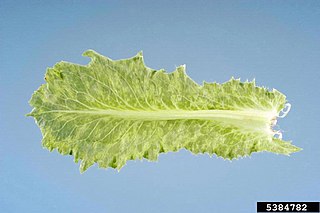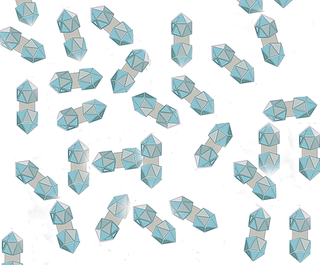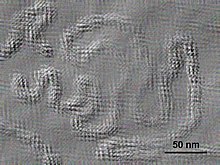
Variegation is the appearance of differently coloured zones in the leaves and sometimes the stems and fruit of plants. Species with variegated individuals are sometimes found in the understory of tropical rainforests, and this habitat is the source of a number of variegated houseplants. Variegation is caused by mutations that affect chlorophyll production or by viruses, such as mosaic viruses, which have been studied by scientists. The striking look of variegated plants is desired by many gardeners, and some have deliberately tried to induce it for aesthetic purposes. There are a number of gardening books about variegated plants, and some gardening societies specialize in them.

Kyasanur forest disease (KFD) is a tick-borne viral haemorrhagic fever endemic to South-western part of India. The disease is caused by a virus belonging to the family Flaviviridae. KFDV is transmitted to humans through the bite of infected hard ticks which act as a reservoir of KFDV.

Lettuce mosaic virus (LMV) is a typical potyvirus, which causes one of the major virus diseases of lettuce crops worldwide.
Citrus tristeza virus (CTV) is a viral species of the genus Closterovirus that causes the most economically damaging disease to its namesake plant genus, Citrus. The disease has led to the death of millions of Citrus trees all over the world and has rendered millions of others useless for production. Farmers in Brazil and other South American countries gave it the name "tristeza", meaning sadness in Portuguese and Spanish, referring to the devastation produced by the disease in the 1930s. The virus is transmitted most efficiently by the brown citrus aphid.

Apple mosaic virus (ApMV) is a plant pathogenic virus of the family Bromoviridae. It is named after its symptoms that were first present on apples. ApMV is a positive sense RNA based virus. The disease itself has several synonyms including Mild Apple Mosaic Virus, Hop Virus, Rose Mosaic Virus, and European Plum Line Patten Virus. It causes a severe yield reduction and decreased life-expectancy of fruit trees.

Bidens mottle virus (BiMoV) is a pathogenic plant virus in the plant virus family Potyviridae. BiMoV is a flexuous filamentous particle, 720 nm long, and belongs to the Potyviridae genus Potyvirus. Like other viruses in this genus, Bidens mottle virus is transmitted both mechanically by sap and by aphids in a stylet-borne fashion.

Cucumber mosaic virus (CMV) is a plant pathogenic virus in the family Bromoviridae. This virus has a worldwide distribution and a very wide host range, having the reputation of the widest host range of any known plant virus. It can be transmitted from plant to plant both mechanically by sap and by aphids in a stylet-borne fashion. It can also be transmitted in seeds and by the parasitic weeds, Cuscuta sp. (dodder).
Peanut stunt virus (PSV) is a plant pathogenic virus in the family Bromoviridae. It is a member of the genus Cucumovirus. The members of this genus are positive-stranded RNA viruses with a multipartite genome. The virus particles have an isometric or spherical shape.
Potato virus Y (PVY) is a plant pathogenic virus of the family Potyviridae, and one of the most important plant viruses affecting potato production.
Prune dwarf virus (PDV) is an economically important plant pathogenic virus affecting Prunus species globally. PDV is found worldwide due to easy transmission through seed, pollen, and vegetative propagation. The virus is in the family Bromoviridae an important family of plant RNA viruses containing six genera, including Alfamovirus, Ilarvirus, Bromovirus, Amularvirus, Oleavirus, and Cucumovirus. PDV belongs to the genera Ilarvirus. It can cause dwarfism of leaves on certain prune and plum plants. It will also cause yellows in sour cherry, especially when present with Prunus necrotic ringspot virus. There are no known transmission vectors, though the pollen of infected cherry trees has been found to infect other cherry trees a small percent of the time.
Sweet potato feathery mottle virus (SPFMV) is a member of the genus Potyvirus in the family Potyviridae. It is most widely recognized as one of the most regularly occurring causal agents of sweet potato viral disease (SPVD) and is currently observed in every continent except Antarctica. The number of locations where it is found is still increasing; generally, it is assumed that the virus is present wherever its host is. The virus has four strains that are found in varying parts of the world.
In the diagnostic laboratory, virus infections can be confirmed by a myriad of methods. Diagnostic virology has changed rapidly due to the advent of molecular techniques and increased clinical sensitivity of serological assays.
Alternanthera mosaic virus (AltMV) is a plant pathogenic virus. AltMV belongs to the virus genus Potexvirus and the virus family Alphaflexiviridae.

Grapevine yellows (GY) are diseases associated to phytoplasmas that occur in many grape growing areas worldwide and are of still increasing significance. The most important grapevine yellows is flavescence dorée.

Watermelon mosaic virus (WMV) also known as Marrow mosaic virus, Melon mosaic virus, and until recently Watermelon mosaic virus type 2 (WMV-2), is a plant pathogenic virus that causes viral infection in many different plants. The virus itself is referred to as Watermelon Mosaic Virus II or WMV-2 and is an isolate of the U.S. WMV-2 is a ssRNA positive strand virus that is part of the Potyviridae or Potyvirus clade. Like all RNA viruses, it contains a protein capsid which protects the inner viral RNA. First described on squash in Florida, WMV arose from a unique recombination of genetic material contributed by Soybean mosaic virus (SMV) and Bean common mosaic virus (BCMV) along with Peanut Stripe virus (PSV).
The Citrus stubborn disease is a plant disease affecting species in the genus Citrus. Spiroplasma citri, a Mollicute bacterium species, is the causative agent of the disease. It is present in the phloem of the affected plant. Originally discovered transmitted by several leafhoppers including Circulifer tenellus and Scaphytopius nitridus in citrus-growing regions of California, it is now spread by the same hoppers in Arizona and Circulifer haematoceps in the Mediterranean region.
Little cherry disease or LChD, sometimes referred to as little cherry, K & S little cherry or sour cherry decline, is a viral infectious disease that affects cherry trees, most notably sweet cherries and sour cherries . Little cherry disease should not be confused with cherry buckskin disease, which is caused by Phytoplasma. Note that both diseases are among the diseases referred to as cherry decline.
Grapevine virus A (GVA) is a moderately common genetic virus that affects Vitis vinifera and American Vitis grapevine species throughout the world and can be fatal if not treated. Grapevine virus A is in the family Betaflexiviridae and genus Vitivirus. The common name for this virus is grapevine closterovirus. Common symptoms in infected grapevines include stem pitting. Although there is a treatment available to cure infected grapevines, it is not one hundred percent effective, so preventative measures are the best solution to the virus. Every inhabited continent on the globe has had breakouts of grapevine closterovirus due to the complex genetic makeup of the virus. Grapevine virus A has a single-stranded RNA genome, which is similar to that of Grapevine virus B. There are multiple strains of the virus that vary both molecularly and biologically which account for the slightly different symptoms exhibited by infected plants.

Sweet potato leaf curl virus is commonly abbreviated SPLCV. Select isolates are referred to as SPLCV followed by an abbreviation of where they were isolated. For example, the Brazilian isolate is referred to as SPLCV-Br.

The Blueberry mosaic associated ophiovirus (B1MaV) is a plant virus which infects blueberry plants, causing a discoloration of the leaves of the plants in a mosaic-like pattern. The disease is found in blueberry plants in many regions of North America, as well as South America, Europe, New Zealand, and South Africa. Within these regions the virus is most often found in high blueberry-yielding areas, but can be spread to other locations. Blueberry mosaic associatedophiovirus is one of seven species in the genus Ophiovirus. It is a member of the Aspiviridae family, in the Serpentovirales order, and in the Milnevircetes class. The Ophioviridae viruses are characterized by a flexible and elongated nucleocapsid that is composed mostly of filamentous structures and is helically symmetrical. It also has a non-enveloped protein capsid that is capable of coiling around itself allowing for a super-coiled structure and the helical symmetry. The virus has the potential to be symptomatic or asymptomatic within plants causing the display of symptoms in only a few plants, but the ability to transmit the virus unknowingly in many plants. B1MaV often remains asymptomatic for long periods of time after initial infection allowing for blind transmission.











